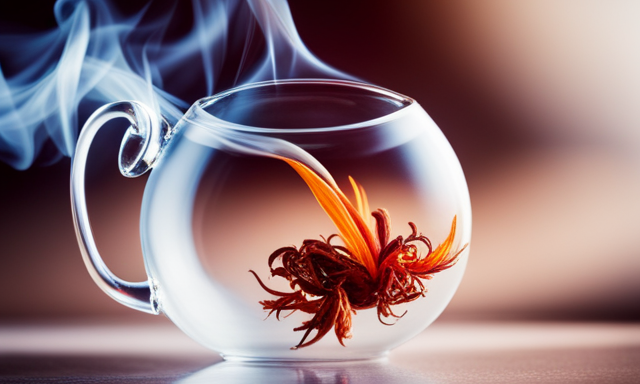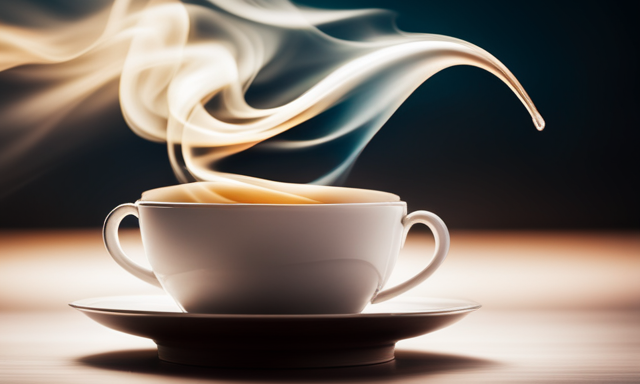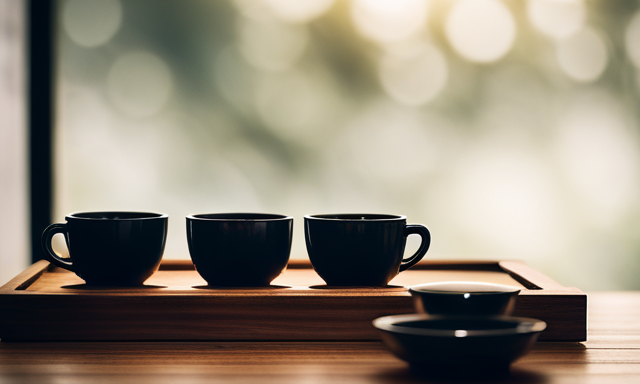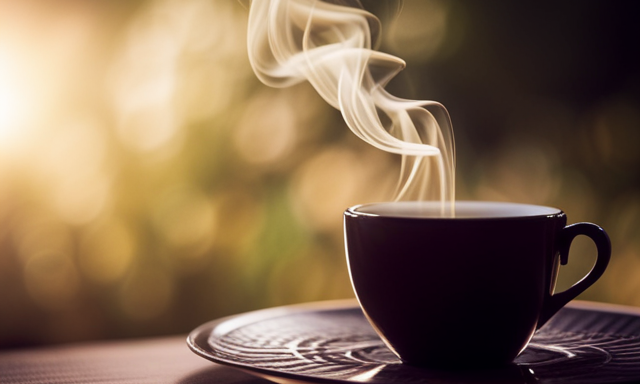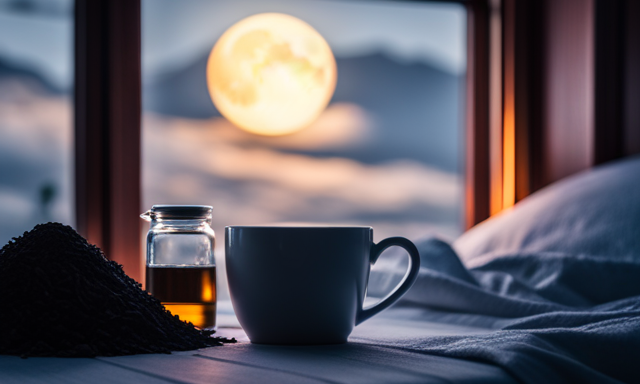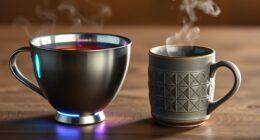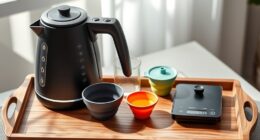As I hold the delicate porcelain teacup in my hands, I can’t help but be captivated by the rich aroma of Phoenix Oolong tea, permeating the air around me. There’s something truly enchanting about this particular tea, with its complex flavors and smooth, velvety texture.
But in order to unlock its full potential, one must master the art of steeping. That’s where I come in. In this article, I will guide you through the intricacies of steeping Phoenix Oolong tea to perfection.
From understanding the tea leaves to selecting the right steeping time for your desired flavor profile, I will provide you with the knowledge and techniques you need to create a truly exceptional tea experience.
So, whether you’re a tea connoisseur or simply looking to expand your tea repertoire, join me on this journey of discovery and let’s delve into the world of Phoenix Oolong tea together.
Key Takeaways
- Steeping times for phoenix oolong tea should be experimented with to find the preferred strength of flavor.
- Adjust the steeping time based on personal preference, with longer steeping times for a stronger flavor and shorter steeping times for a milder flavor.
- Tea infusers or tea bags can be used for convenient brewing, with infusers allowing for easy removal of tea leaves and tea bags providing a mess-free brewing experience.
- Water temperature should be adjusted for optimal extraction, with higher temperatures bringing out floral and fruity notes and lower temperatures emphasizing roasted flavors.
Understanding Phoenix Oolong Tea
Get ready to dive into the delicious world of Phoenix Oolong Tea and discover its unique flavors and aromas!
Phoenix Oolong Tea, also known as Fenghuang Dancong, is a type of Chinese oolong tea that is highly regarded for its complex and captivating taste profile.
To fully appreciate the flavors of Phoenix Oolong Tea, it is essential to understand the importance of brewing temperature. The ideal brewing temperature for this tea is around 90-95°C (194-203°F), which allows the leaves to unfurl and release their full potential.
Not only does Phoenix Oolong Tea offer a delightful sensory experience, but it also boasts numerous health benefits. Rich in antioxidants, this tea can help boost the immune system, improve digestion, and promote overall well-being.
Now that we’ve explored the brewing temperature and health benefits of Phoenix Oolong Tea, let’s move on to choosing the right tea leaves for the perfect cup.
Choosing the Right Tea Leaves
When selecting the appropriate leaves, it is crucial to consider the specific type and origin of the tea. Phoenix Oolong tea comes in different grades, ranging from lower to higher quality. The leaves of higher-grade Phoenix Oolong tea are usually more tightly rolled and have a more distinct aroma and flavor. These leaves are carefully hand-picked and processed, ensuring the best quality for your tea experience.
Understanding the tea’s origin is also important as it can affect the taste and characteristics of the tea. Phoenix Oolong tea is traditionally grown in the Phoenix Mountain area in Guangdong, China, where the unique climate and soil conditions contribute to its exceptional taste.
Now that you’ve chosen the right tea leaves, let’s move on to preparing your teapot and water for the perfect brew.
Preparing Your Teapot and Water
To prepare your teapot and water, follow these steps:
-
Thoroughly clean your teapot with hot water to remove any residue or impurities that may affect the taste of your tea.
-
Consider using filtered water, as studies have shown that it can enhance the flavor of your tea by reducing impurities and minerals that can alter its taste.
-
Preheat your teapot by filling it with hot water and letting it sit for a few minutes. This helps to maintain the optimal temperature for brewing.
-
Control the water temperature. For Phoenix Oolong tea, the ideal water temperature is around 185°F (85°C). Maintaining the right temperature will ensure that the tea leaves steep properly, releasing their full flavor.
Now that your teapot and water are ready, let’s move on to measuring the perfect amount of tea.
Measuring the Perfect Amount of Tea
To ensure a perfect brew, measuring the right amount of tea is crucial. Striking the right balance is key. Too little tea leaves will result in a weak and flavorless brew, while too much can make it overpowering and bitter.
The general rule of thumb is to use one teaspoon of tea leaves for every 8 ounces of water. However, this can vary depending on personal preference and the type of tea you’re brewing. It’s always a good idea to experiment and adjust the amount of tea to suit your taste.
Once you’ve measured the perfect amount of tea, it’s time to explore different steeping techniques to bring out the full flavor and aroma.
Now that you’ve got the right amount of tea, let’s dive into the next section to discover the perfect steeping times for different flavor profiles.
Steeping Times for Different Flavor Profiles
Once you’ve measured the perfect amount of tea, it’s time to explore different steeping techniques to bring out the full flavor and aroma. The steeping time for Phoenix Oolong tea can vary depending on the desired flavor profile. By adjusting the steeping temperature and tea brewing methods, you can unlock different taste experiences. Below is a table that outlines the recommended steeping times for various flavor profiles of Phoenix Oolong tea:
| Flavor Profile | Steeping Time |
|---|---|
| Light and Floral | 1-2 minutes |
| Rich and Roasted | 2-3 minutes |
| Fruity and Sweet | 3-4 minutes |
| Earthy and Nutty | 4-5 minutes |
| Balanced | 2-3 minutes |
Experimenting with different steeping times can help you find the perfect balance of flavors for your taste preferences. Understanding multiple infusions is the next step in fully appreciating the complexity of Phoenix Oolong tea.
Understanding Multiple Infusions
Exploring the world of tea is like embarking on a delightful journey where multiple infusions of your favorite brew unveil new layers of flavor and depth. When it comes to Phoenix Oolong tea, understanding multiple infusions is key to fully appreciating its complexity.
Each infusion offers a unique taste experience, revealing different nuances and subtleties. To achieve the best results, it’s important to master the art of steeping techniques.
Phoenix Oolong tea leaves can withstand multiple infusions, usually ranging from three to five. The first infusion is typically shorter, lasting around 30 seconds, while subsequent ones can be extended by 10 to 15 seconds. This gradual increase in steeping time allows the flavors to fully develop and intensify.
By experimenting with different steeping techniques, you can unravel the full potential of this exquisite tea.
Transitioning into the subsequent section about proper tea tasting techniques, let’s now explore the art of savoring each sip.
Proper Tea Tasting Techniques
Now that we understand the art of multiple infusions, let’s delve into the proper tea tasting techniques.
When it comes to experiencing the full flavor profile of Phoenix Oolong tea, it is essential to use the correct brewing temperature and employ tea cupping techniques.
Firstly, the brewing temperature should be around 195°F (90°C) to bring out the tea’s rich aroma and complex flavors.
Secondly, tea cupping involves slurping the tea to aerate it and spread the liquid across the palate, allowing for a more intense taste experience.
It is also important to pay attention to the tea’s appearance, aroma, and mouthfeel.
By following these techniques, you can fully appreciate the nuances of Phoenix Oolong tea.
In the next section, we will explore the best practices for storing and preserving tea leaves without compromising their quality.
Storing and Preserving Tea Leaves
To properly store and preserve your tea leaves, it’s crucial to keep them in an airtight container. Studies have shown that exposure to air can cause a significant loss in flavor and aroma.
There are several storing methods you can employ to ensure tea freshness. Firstly, store your tea leaves in a cool and dark place, away from sunlight and strong odors. Temperature fluctuations can affect the quality of the tea, so it’s essential to avoid storing it in areas prone to heat or cold.
Additionally, consider using opaque containers to further protect the tea from sunlight. It’s also important to keep your tea away from moisture, as it can lead to mold growth.
By following these storing methods, you can maintain the freshness of your tea leaves and enjoy a delightful cup every time.
Now, let’s move on to experimenting with tea accessories.
Experimenting with Tea Accessories
Get ready to enhance your tea-drinking experience with a variety of accessories that will take your enjoyment to the next level.
When it comes to steeping phoenix oolong tea, you have two primary options: using a teapot or a gaiwan. A teapot is perfect for making larger batches of tea, allowing for multiple servings. On the other hand, a gaiwan is a small, lidded bowl that provides better control over the steeping process, resulting in a more concentrated flavor.
Additionally, experimenting with different water temperatures can also affect the taste of your tea. Higher temperatures, around 195°F, bring out the tea’s floral and fruity notes, while lower temperatures, around 175°F, emphasize its roasted flavors.
By utilizing these accessories and playing with water temperatures, you can truly enhance your tea experience, unlocking a world of flavors and aromas.
Transitioning to the subsequent section, let’s explore other ways to elevate your enjoyment of phoenix oolong tea.
Enhancing Your Tea Experience
Enhancing your tea experience can be as simple as adding a squeeze of fresh lemon juice to your cup, which can provide a refreshing citrusy twist to the flavors of the tea. For example, imagine sipping on a warm cup of phoenix oolong tea infused with the tangy brightness of lemon, transporting you to a sunny afternoon in a lush tea garden.
Tea brewing techniques:
- Experiment with different steeping times to find your preferred strength of flavor.
- Use a tea infuser or tea bags to easily brew your tea.
- Adjust the water temperature based on the type of tea for optimal extraction.
- Consider using a teapot to enhance the brewing process and serve multiple cups.
Tea pairing suggestions:
- Pair phoenix oolong tea with light snacks like cucumber sandwiches or lemon shortbread cookies.
- Try serving it alongside fresh fruits such as peaches or strawberries for a balance of flavors.
- For a more indulgent experience, pair it with a slice of citrus-flavored cake or a creamy lemon tart.
- Experiment with different tea blends and flavors to find unique pairings that suit your taste preferences.
Frequently Asked Questions
Can phoenix oolong tea be steeped multiple times?
Yes, phoenix oolong tea can be steeped multiple times. Each steeping releases different flavors and aromas. The steeping time can vary depending on personal preference, but generally, 3-5 minutes is recommended for the first steeping, with subsequent steepings increasing by 1-2 minutes.
What is the best temperature for steeping phoenix oolong tea?
The best temperature for steeping Phoenix Oolong tea is around 190-200°F. This temperature allows the leaves to unfurl and release their flavors fully. Proper brewing technique involves using fresh water and steeping for 2-3 minutes.
Can I use tap water to brew phoenix oolong tea?
I recommend using filtered water instead of tap water for brewing phoenix oolong tea. The quality of water affects the taste of the tea, and tap water may contain impurities that can alter the flavor.
How should I store phoenix oolong tea leaves to maintain their freshness?
To maintain the freshness of Phoenix Oolong tea leaves, store them in an airtight container away from light, moisture, and strong odors. This will help preserve their flavor and aroma for an extended period.
What are some common tea accessories that can enhance the experience of drinking phoenix oolong tea?
Using common tea tools like a clay teapot and a bamboo tea tray can enhance the experience of drinking phoenix oolong tea. These accessories improve aroma, taste, and presentation, taking your tea enjoyment to new heights.
Conclusion
In conclusion, steeping Phoenix Oolong tea is a delicate process that requires precision and patience. By choosing the right tea leaves, preparing your teapot and water, and measuring the perfect amount of tea, you can create a truly exquisite tea experience.
One interesting statistic to note is that the steeping time for Phoenix Oolong tea can vary from 45 seconds to 5 minutes, depending on the desired flavor profile. This wide range allows for experimentation and customization, ensuring that every cup of tea is tailored to your preferences.
So go ahead, steep, sip, and savor the rich and complex flavors of Phoenix Oolong tea.

